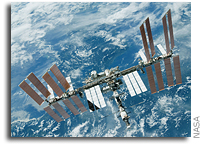NASA International Space Station Research Highlights Dec. 2010

Three crew members completed nominal runs with the Psychomotor Vigilance Self Test (Reaction Self Test). The experiment is a portable five-minute reaction time task that allows crew members to monitor the daily effects of fatigue on performance while aboard the station.
Cady Coleman and Paolo Nespoli completed their first session with the Nutritional Status Assessment (Nutrition) . This comprehensive in-flight study is designed to understand changes in human physiology during long-duration spaceflight. This study includes measurements of bone metabolism, oxidative damage, and chemical and hormonal changes; as well as assessments of the nutritional status of the crew members participating in the study. The results have an impact on the definition of nutritional requirements and development of food systems for future space exploration missions.
Coleman completed her first session with the Evaluation of Maximal Oxygen Uptake and Submaximal estimates of VO2max before, during and after long-duration space station missions (VO2max). The experiment documents changes in maximum oxygen uptake over long-duration missions.
In conjunction with VO2max, Coleman performed her first session of ESA-sponsored Thermoregulation in Humans During Long-Term Spaceflight (Thermolab). This investigation evaluates the thermoregulatory and cardiovascular adaptations during rest and exercise in the course of a long-duration microgravity exposure.
Coleman performed her first Echo Scan session for (Integrated Cardiovascular). This investigation quantifies the extent, time course and clinical significance of cardiac atrophy, or the decrease in the size of the heart muscle, associated with long-duration spaceflight. This experiment will determine how much cardiac atrophy occurs during spaceflight and how fast it develops. It also determines whether this atrophy causes problems with the heart’s pumping or electrical function, and how both the atrophy and any associated changes develop.
In conjunction with Integrated Cardiovascular, Coleman performed her first session of ESA-sponsored Vascular Echography (Vessel Imaging). The payload evaluates the changes in central and peripheral blood vessel wall properties, such as thickness and compliance, in long-duration crew members.
The Japan Aerospace Exploration Agency-sponsored Chaos, Turbulence and its Transition Process in Marangoni Convection (Marangoni) EXP experiment performed its 24th run and is now complete. This is one of two physics experiment analyzing the behavior of a surface-tension-driven flow in microgravity. The next planned activity will be a cassette exchange to begin the UVP experiment.
Jorge Sotomayor, Lead Increment Scientist
Expedition 25/26









